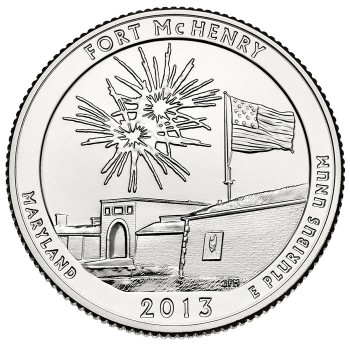The fourth quarter release for 2013 from the United States Mint is the Fort McHenry National Monument and Historic Shrine Quarter. This strike, the nineteenth issued as part of the Mint’s America the Beautiful Quarters® Program, honors the national site in Maryland. It marks an entrance into circulation on August 26, 2013.

Also on the 26th, the US Mint begins selling the coins within rolls, sets and bags at www.usmint.gov/catalog. These Fort McHenry quarters are produced at US Mint facilities in Denver, Philadelphia and San Francisco.
Those from San Francisco are produced only for coin collectors so they will not appear in circulation down the road like the ones out of Denver and Philadelphia. The US Mint also strikes unique proof and uncirculated versions for collectors, with most of them already available also at www.usmint.gov/catalog.
Like past America the Beautiful Quarters, several designs were proposed for the reverse or tails side of the Fort McHenry National Monument and Historic Shrine Quarter. These designs were reviewed by the Citizen’s Coinage Advisory Committee (CCAC) and the U.S. Commission of Fine Arts (CFA). After recommendations from the Mint, the Treasury Secretary selected the final designs for all five 2013 quarters.
Found on the reverse of the Fort McHenry quarter is a scene that would be seen during the "Defenders Day" celebration, the centerpiece for an annual event held at Fort McHenry. The fireworks are meant to symbolize the "rocket’s red glare." Inscriptions read FORT McHENRY, MARYLAND, 2013 and E PLURIBUS UNUM. The reverse was both designed and sculpted by Joseph Menna.
All America the Beautiful Quarters, whether they feature national parks or national sites, have common obverses (heads side). Shown is John Flanagan’s portrait of George Washington with inscriptions reading UNITED STATES OF AMERICA, IN GOD WE TRUST, LIBERTY and QUARTER DOLLAR.
Since its start in 2010, there have been five America the Beautiful Quarters released annually. That will continue until 2020 with the final one in 2021 for a total of fifty-six designs. The Treasury Secretary has the discretion to extend the program. All strikes feature reverses emblematic of selected sites of national interest throughout the United States and its territories.
There were three other coins released before the Fort McHenry National Monument and Historic Shrine Quarter. They included the White Mountain National Forest Quarter, Perry’s Victory and International Peace Memorial Quarter, and the Great Basin National Park Quarter. The last strike, scheduled for release in November, is the Mount Rushmore National Memorial Quarter.
Fort McHenry National Monument and Historic Shrine information
Fort McHenry National Monument and Historic Shrine was established to commemorate the located in the Baltimore Harbor of Maryland. During the War of 1812, Baltimore Harbor played an important role against Great Britain. Fort McHenry was built to help protect the harbor during the American Revolution and was used again during the War of 1812.
On September 13, 1814, British troops attempted to take Baltimore Harbor, which was poorly protected. Only Fort McHenry and a few sunken blockades stood in the British warship’s way. The battle against fort McHenry lasted for 25 hours, with the British warships eventually retreating as Fort McHenry withstood their bombardment, mostly due to poor accuracy from the British ships.
Francis Scott Key was a witness to this battle while aboard a truce ship. The firefight inspired him to write "The Star-Spangled Banner," a poem that became the national anthem years later.
Since the war of 1812, Fort McHenry has served several purposes, such as a military prison, a hospital and a Coast Guard base. Fort McHenry became a national park in 1925 and in 1939 it was finally named Fort McHenry National Monument and Historic Shrine. It is estimated that almost 750,000 people visit it each year.
